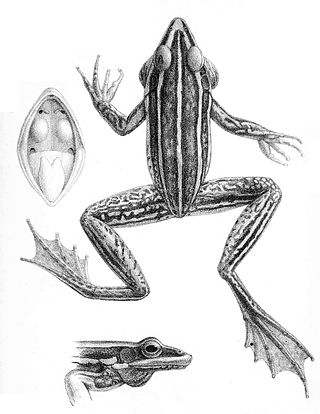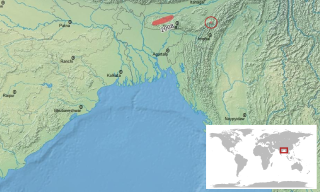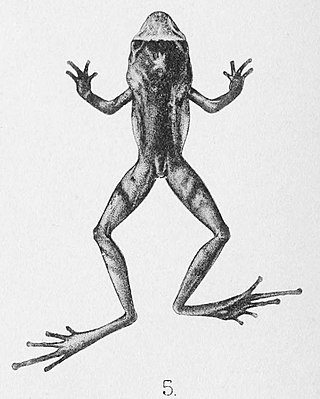
Philautus is a genus of shrub frogs in the family Rhacophoridae from Asia. Some species in this genus are now considered extinct by IUCN, while others are widespread and abundant. The taxonomy of the group is unclear, with many poorly described species.

Conraua, known as slippery frogs or giant frogs is a genus of large frogs from sub-Saharan Africa. Conraua is the only genus in the family Conrauidae. Alternatively, it may be placed in the family Petropedetidae.
Bufoides kempi is a species of true toad, family Bufonidae. This poorly known species is endemic to Meghalaya, Northeast India. It is only known with certainty from its type series collected "above Tura" at 2,500 ft (760 m) in the Garo Hills no later than 1919; there is also a possible record collected at around 2009. Its common names are Kemp's Asian tree toad, Garo Hills toad, and Garo Hills tree toad. The specific name kempi honours Stanley Wells Kemp, an English zoologist and anthropologist.
Leptopelis bequaerti is a species of frog in the family Arthroleptidae. It is endemic to Liberia and only known from its type locality, Gbarnga, and from Mount Coffee. Common name Gbanga forest treefrog has been coined for it. It is a poorly known species with uncertain taxonomic validity.

Humerana oatesii is a species of frog in the family Ranidae. It is endemic to Burma. This species is only known from type series collected from "near Toungoo" in the Pegu Range. The specific name oatesii honours Eugene W. Oates, English civil servant and naturalist who collected the type series. However, the common name Toungoo frog has been proposed for it.
Philautus cornutus is a species of frog in the family Rhacophoridae. It is endemic to Indonesia. It has been observed 1529 and 1907 meters above sea level.

Philautus garo is a species of frog in the family Rhacophoridae. It is endemic to India, and has been recorded in the Garo Hills of Assam and Meghalaya, and in Dzulake in Nagaland. This frog has been observed between 90 and 500 meters above sea level.
Pseudophilautus halyi, known as pattipola shrub frog, is an extinct species of frog in the family Rhacophoridae. It was endemic to Sri Lanka. It is only known from the holotype collected in 1899. The specific name halyi honours Amyrald Haly, the first director of the Ceylon Museum, author of the "Natural History of Ceylon", and the collector of the holotype.

Philautus kempii is a species of frog in the family Rhacophoridae. It is known with certainty from its type locality, Upper Rotung in Arunachal Pradesh, Northeast India, in the area also claimed by China. It is also reported from Arunachal Pradesh in general as well as from extreme eastern Tibet; these might represent another species. Very little is known about this species, and even its taxonomic validity remains uncertain.
The Leyte tree frog is a species of frog in the family Rhacophoridae. It is endemic to the Philippines.
Pseudophilautus leucorhinus, also known as white-nosed shrub frog, pointed-nosed shrub frog, whitenose bubble-nest frog, and Marten's bush frog, was a species of frog in the family Rhacophoridae. It was endemic to Sri Lanka. It is only known from the holotype that was collected some time before 1856 from the indefinite type locality "Ceylon". Pseudophilautus wynaadensis from southwestern India has been considered conspecific with this species, but these species are now considered distinct.
Pseudophilautus limbus, also known as Haycock shrub frog, is a species of frogs in the family Rhacophoridae. It is endemic to southwestern Sri Lanka, including its type locality, Haycock Hill (Hiniduma) Forest Reserve. The specific name limbus, from the Latin for "edge" or "border", refers to the species originally having been known only from the border of the Haycock Hill Forest Reserve.
Philautus microdiscus is a species of frog in the family Rhacophoridae. It is endemic to India, only known from Abor Hills in Arunachal Pradesh. This little-known species inhabits tropical moist lowland forests.

Raorchestes parvulus is a species of frog in the family Rhacophoridae. It is found from eastern Bangladesh east through Myanmar and Thailand to Cambodia, northern Vietnam, Laos, and Peninsular Malaysia. Its distribution might well extend into northeastern India and southern China. This species was first described by George Albert Boulenger based on seven specimens collected by Leonardo Fea from Karen Hills, Burma.

Raorchestes travancoricus, variously known as the Travancore bushfrog, Travancore bubble-nest frog, or Travancore tree frog, is a species of frog in the family Rhacophoridae. The species is endemic to the southern Western Ghats, India. Its specific name, travancoricus, as well as its three common names, refer to its type locality, Bodinayakkanur in the former Travancore state.
Philautus umbra is a species of frog in the family Rhacophoridae. It is endemic to Borneo and only known from Mount Api in northern Sarawak, Malaysia, although it might also occur in the adjacent Brunei.
Pseudophilautus zal, commonly known as the white blotched shrub frog, is an extinct species of frog in the family Rhacophoridae. It was endemic to Sri Lanka. It is only known from the type series consisting of three old museum specimens.

Polypedates macrotis, commonly known as the dark-eared treefrog, sometimes also Bongao tree frog, Bongao bubble-nest frog, Baram whipping frog, or brown-striped tree frog, is a species of frog in the family Rhacophoridae. It is found in the central peninsular Thailand, Sumatra, Borneo, and Sulu Archipelago as well as a range of other Philippine islands.

Philautus everetti is a species of frog in the family Rhacophoridae found in the Philippines and Malaysia. Its natural habitats are subtropical or tropical moist lowland forests, subtropical or tropical moist montane forests, and rivers. In Borneo, this species occurs in the mountainous area from Gunung Kinabalu National Park in Sabah to Gunung Mulu National Park in Sarawak. It is usually observed between 750 and 1800 meters above sea level, but it is rarely seen as low as 300 meters above sea level.
Stanley Wells Kemp, FRS was an English marine biologist.









